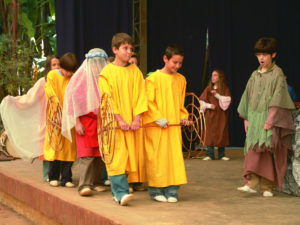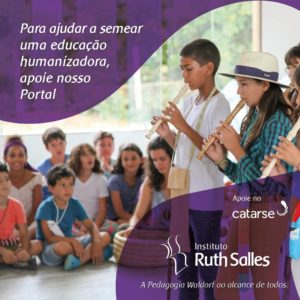 The 9 year old child
The 9 year old child
By Cristina Maria Brigagão Abalos, Dora Regina Zorzetto Garcia and Vilma Lúcia Furtado Paschoa.
At age 9, the child, previously identified with the world around him, now goes through a very special moment, moving further and further away from fantasy and the feeling of unity and integration with nature and his environment. The child feels alone for the first time, he feels as an individual, separate, creating an internal space.
The pedagogical task is to build a bridge between the 9-year-old's inner space and the world from which he is moving away.
It is of fundamental importance that, at this age, the desire to grow is cultivated, to want to know the world and act in it, bringing images that translate in depth the moment that the 9-year-old child goes through! That man cannot be passive on Earth, that he must work. With his work, he transforms the environment and ensures its survival. Professions are addressed, as well as the action of man in the world. This can be directed in the most varied ways, and thus the man dignifies himself.
As a suggestion, the study of professions can be approached basically on two major themes: bread, primordial food, and the house, seen as the construction of one's own corporeality, as the shelter for "being in the world". Under the theme of bread, students can learn to cultivate at school or at home, take care of the plantation, wait for it to germinate and ripen, learn about harvesting, threshing, grinding wheat, building the clay oven, and finally , the making of bread. Other products can also be grown in a vegetable garden, and students learn all the trades connected with cultivating the land, until the food is on our table. Under the theme of the house, the various types of housing in the world can be addressed and how they are built, according to the natural resources available and the customs of each culture. Here, too, different professions emerge, linked to this precious opportunity to introduce students to much of what man can do with his hands, and the ability they have to transform.
THE THEATER FOR 9-YEAR-OLDS CHILDREN
Every day it is natural for children to arrive at school in different moods. To harmonize the group, it is advisable to do rhythmic exercises*, recitations and singing. At this age, musical exercises can be more complex and can be practiced, for example, in canons: a group starts a musical theme already learned in unison and is followed at a distance of one or more measures by another group(s) until the end.
All the contents mentioned above bring countless, varied and rich possibilities of dramatization. How is theater for 9-year-olds different from theater for younger children? – Children still memorize all the chosen text, but some, who feel more secure, can have longer individual lines. A child should never be forced to expose himself, this will come with time, as they all end up involved by the context and by the adequacy of the themes to the moment of their development. The drama of the strong images of the Old Testament stories, such as Joseph of Egypt, David and Goliath, for example.
The costumes can now be a little more elaborate, with some elements that recall, for example, periods or professions, as well as more and more varied objects of the scene, many of which the children themselves can manufacture.
Works with drawing and painting can be done as experiences of the contents of the play, experimenting with new intensities and color combinations, deepening the chosen themes and the process of assembling the play.
The scenarios can be composed only with colored cloths, since the most important focus is the children and their performance.
For a 9-year-old child, the choice of a piece should be inspired by themes that arouse enthusiasm for human action and rescue their conviviality and participation in the world. It is man transforming his environment. For this, the plays should have enterprising, active characters, who together, adding strength, complete tasks and can taste the fruit of the task accomplished.
As an example, we chose the play “O Grão de Trigo”, which encompasses several themes suitable for this age: bread, professions, collective and shared work, the harmony existing between man and the domestic animals that serve him and, for on the other hand, the nature that complements and supports them. The “boy” of the play is the reason for all the work that will result in the bread.
If the text summarizes the content given in the classes, it is not necessary to tell the story in advance. As each element is presented, the corresponding lines are introduced in the rhythmic part of the beginning of the class. The indication remains that everyone decorates everything.
At first, the language and its resources are explored, for example the alliterations in the speech of the wind; the gestures, which naturally follow from it, in the strong and cadenced speech of the farmers, accompanied by the character's firm steps; or even the rhythms expressed in the slow, slurred speech of cows and oxen. Everyone participates in the speech of the choir, while “the sun”, “the moon” and “the boy” can each be represented by a student.
In addition to the songs that make up the play, it is suggested to add small melodies, such as the sound of instruments featuring certain characters (rain-stick, reco-reco, whistles with bird sounds, etc.)
After an intense experience in which all students have the chance to experience different characters, the teacher distributes the roles according to pedagogical criteria. It is worth remembering that the assembly of a play is not a mere playful activity, but an extremely valuable pedagogical resource for the development of the child and the harmonization of the group.
A shy child would do well to be the little grain of wheat that breaks through the earth, grows and blossoms into golden spikes; or, even, for a child with egocentric traits, the experience of a grain of wheat transformed into bread to serve as food would be quite therapeutic. Although stardom should be avoided, another criterion for choosing roles is the appreciation of the child's aptitudes and characteristics, his talents. Cheerful and communicative children would certainly do well in the role of larks.
In this piece, it is possible to wear colored tunics (green for the field, raw for the grains of wheat, yellow for the sun, etc.), explore the headdresses featuring different characters (crown adorned with ears of wheat, hats with ears, horns , identifying the animals, a gold paper crown for the sun and a silver paper crown for the moon). For the representation of the plow, the roller and the harrow, the movement of the body itself is suggested. The “winds”, the “rains” and the “larks” can wear light and transparent fabrics over the tunics.
At the age of 9, children move more freely on stage, being able to perform a more elaborate work and giving greater personal expression to their performance, always within the general guidelines of the teacher.
* Rhythm exercises – Every day, when children arrive in the classroom, they come from different environments and present themselves in a special mood: some arrive breathless because they were late, others tired, because they were in a lot of traffic, others watched a fight between parents or even worse. They are not ready for learning. The main function of the rhythmic part is to harmonize these children and prepare them for learning. A poem, no matter how small and simple, said in chorus at the beginning of the school day, for example, helps to ease students' dispersion and make them feel that they are part of a whole. In a playful and joyful way, rhythm exercises are taught, with poetry and songs – which may even be part of a future play – performed by everyone, with claps, gestures, movement, “tuning” the class. This is how the body schema, spatiality, diction, attention, social integration and many other aspects are worked. This beginning of the class, which we call the rhythmic part, is repeated, in this way, for three or four weeks, when then something is changed, not all at once, that is, a poem is replaced by a new one, then a new one. music and so on, following the themes worked in class, the matter. In the long run, rhythmic work develops qualities and creates dispositions and skills for theatrical work. Up to 9 years old, it is important that the rhythmic part is performed in a circle, with the children standing and free to move. The circle is the perfect form, which integrates everyone and where each one sees the whole.
***


